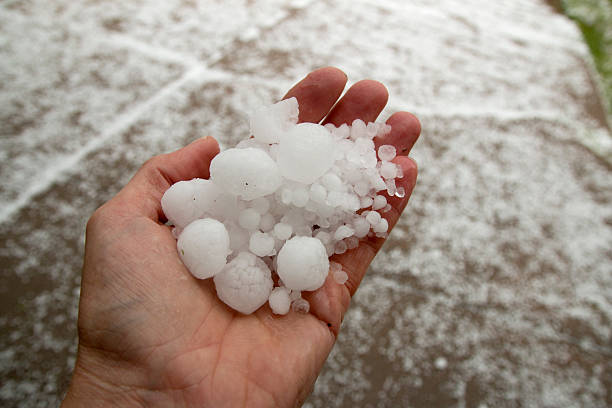
Hailstorms can be unpredictable and destructive, often leaving homeowners with costly roof repairs after a hail storm. Even a brief hailstorm can cause significant damage, depending on the size of the hailstones, wind speed, and the condition of your roof. In this post, we’ll explore how hail affects different roofing materials, signs of damage to look for, and steps you can take to prevent costly repairs.
Hail damage occurs when hailstones impact various outdoor components, including roofs, cars, windows, and siding. Hailstones form in thunderstorms when updrafts carry water droplets into the freezing levels of the atmosphere. These droplets freeze into small balls of ice, which can grow larger as they are repeatedly carried upward and downward through the storm cloud. Eventually, the hailstones become too heavy to stay suspended and fall to the ground, potentially causing significant damage to structures and vehicles. Understanding how hail forms and the damage it can cause is crucial for homeowners looking to protect their property.
Hail damage varies based on several factors, such as the size of the hailstones, wind direction, and the age of your roofing materials. Here’s how it can affect different types of roofs: In addition to direct impacts, hail can contribute to broader storm damage that affects the overall integrity of your roof.
Asphalt shingles are the most common roofing material, but they’re also vulnerable to hail damage. Hailstones can:
Metal roofs are more resilient, but metal roofing can still suffer from:
Tile and slate roofs are highly durable, but large hailstones can:
Hail can splinter or crack wooden shingles, making them more susceptible to water damage and rot. These issues can lead to roof leaks, causing further water damage and rot.
After hail storms, it’s crucial to inspect your roof for signs of damage. Look for:
While you can’t stop hail from falling, you can take steps to minimize roof damage:
Spotting hail damage from the ground can be challenging, but there are several indicators that your roof may have sustained hail damage. Look for:
These signs can help you determine if your roof has been affected by a hailstorm and whether you need to take further action.
Not all hail damage is visible from the ground or even during a basic roof inspection. Hidden hail damage can occur when hailstones penetrate the roof’s surface, causing damage to the underlying structure. Additionally, related roof hail damage can affect other components of the roofing system, such as roof vents, gutters, and flashing. A professional roofing contractor can identify these hidden and related damages through a thorough roof inspection and recommend the necessary repairs to ensure your roof remains in good condition.
Most homeowners’ insurance policies cover roof hail damage, but the extent of coverage can vary depending on your specific policy and insurance company. It’s essential to review your policy to understand what is covered and what is not. If you suspect that your roof has sustained hail damage, contact your insurance company promptly to report the damage and initiate the claims process. A professional roofing contractor can assist you in navigating the insurance process, ensuring that you receive the necessary repairs or replacement for your hail-damaged roof. Understanding your coverage and working with a professional can help you manage the aftermath of a hailstorm more effectively.
If your home has been hit by hail, follow these steps:
Hail damage might not always be immediately visible, but ignoring it can lead to bigger problems like leaks and structural deterioration. Being proactive with regular inspections and choosing durable roofing materials can save you thousands in repairs. Understanding the process of insurance claims can help you manage repairs more effectively. If you suspect hail damage, don’t wait—contact a roofing professional to assess and protect your home.